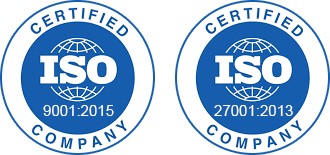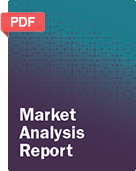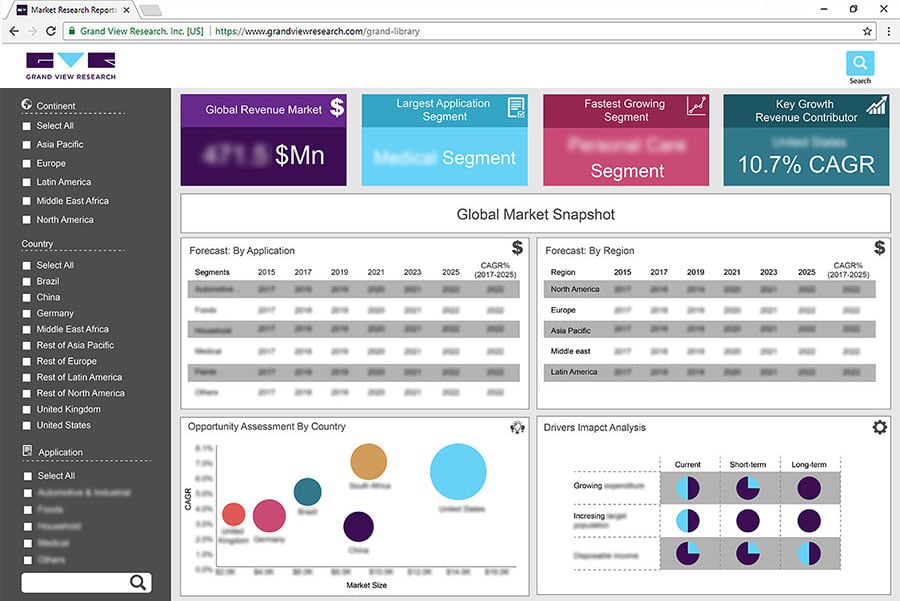- Home
- »
- Plastics, Polymers & Resins
- »
-
U.S. Automotive Wrap Films Market Report, 2021-2028GVR Report cover
![U.S. Automotive Wrap Films Market Size, Share & Trends Report]()
U.S. Automotive Wrap Films Market Size, Share & Trends Analysis Report By Application (Heavy-duty Vehicles, Medium-duty Vehicles, Light-duty Vehicles), By Location, And Segment Forecasts, 2021 - 2028
- Report ID: GVR-4-68039-300-4
- Number of Report Pages: 46
- Format: PDF, Horizon Databook
- Historical Range: 2017 - 2019
- Forecast Period: 2021 - 2028
- Industry: Bulk Chemicals
Report Overview
The U.S. automotive wrap films market size to be valued at USD 4.32 billion by 2028 and is expected to grow at a compound annual growth rate (CAGR) of 18.8% during the forecast period. The rising trend of consumer spending on automobile customization coupled with the rising number of medium-duty vehicles used as transportation vehicles, food trucks, and others is expected to drive the demand for automotive wrap films in the country over the forecast period. Automotive wrap films are of two types: cast vinyl films and calendered vinyl films. The raw materials used for manufacturing wrap films include PVC and other added ingredients such as plasticizers, pigments, and UV absorbers. PVC is generally a very rigid polymer and requires plasticizers to make it flexible for use. Plasticizers can be classified as monomeric and polymeric. Pigments and UV absorbers are used to improve films’ resistance and against UV radiation.
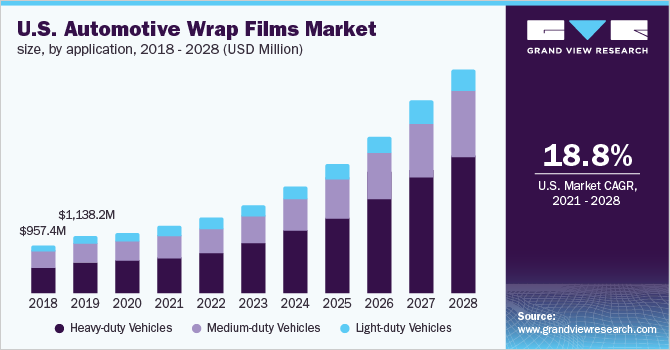
Growing advertising industry with the use of sign and graphics, increasing demand for advertising on automobiles and low cost associated with vehicle wraps compared to vehicle paint are the major factors driving the market growth. However, stringent government regulations dictating the use of polyvinyl chloride (PVC) are expected to restrain market growth over the forecast period.
Automotive wrap films protect the vehicle from scratches, scuffs, and sun fading, thus encapsulating the vehicle finish and maintaining its resale value. Fleet wraps are most suitable for promotion and advertising for new product launches and marketing events as well as increase name recognition 15 times as compared to other advertising mediums.
Hydro dipping is gaining popularity for use in bumpers, as the automotive wrap films get easily torn in bad road conditions due to stones. The processing time required for hydro dipping is less as compared to the installation of automotive wrap films. Various automotive enthusiasts have started using hydro dripping as their primary option for customization due to the low cost compared to automotive wrap films.
U.S. Automotive Wrap Films Market Trends
The wrapping tool offers the consumers to personalize and make their car stand out from others. In addition, the time taken to wrap a car is less as compared to completely repainting a car. Moreover, it is inexpensive and protects the paint of the car. These factors are expected to aid the market growth over the forecast period.
Maintenance of these wraps is easy if the high-quality wrap is used on the vehicle. These are scratch resistant and have a long shelf life. Moreover, it is easy to remove the wrap and rewrap it with a different color. In addition, they look like real paint and no one can differentiate them from the real paint. These factors are expected to propel the market forward during the forecast period.
However, hydro dipping poses a major challenge to the wrap market as it is a less expensive and relatively easy process. In addition, in the longer run, the color of the wrap fades and gives a dull look to the vehicle and needs to be rewrapped again. These factors are expected to hinder the market growth over the forecast period.
Wraps are used for promotional activities by different companies to promote themselves or a new product that they are about to launch. They are used to capture the eye of the customer and are a good tool for advertising. It is a great tool to reach out to a larger audience. This is expected to create lucrative opportunities for the automotive wrap market over the forecast period.
Location Insights
The exterior location segment led the U.S. automotive wrap films market and accounted for more than 90.0% share of the revenue in 2020. This high share is attributable to the fact that automotive wrap films are primarily utilized on hoods, doors, bumpers, bonnets, and other components. Automotive wrap films protect the original paint job and easy cleaning of vehicles. Various automobile enthusiasts change wrap films frequently to give a new surface finish and color to the vehicles. Typically, automotive wrap films have a service life of 5 to 6 years.
Automotive wraps films are applied on dashboards, cup holders, and parts of the steering wheel, glove compartments, and others in the interior part of the vehicles. Interior automotive wrap film offers a prolonged service life of up to 12 to 15 years and enables easy cleaning.
Application Insights
The light-duty vehicles application segment led the market and accounted for more than 53.8% of the revenue share in 2020. This high share is attributable to the rising demand for wrap films as a cost-effective solution compared to vehicle paint, especially for high-end vehicles such as Audi, Mercedes, Porsche, Volkswagen, and BMW. Motorsports and vehicle detailing have become a growing trend among consumers for which automotive wraps are being increasingly used to enhance the aesthetic appeal of cars and bikes.
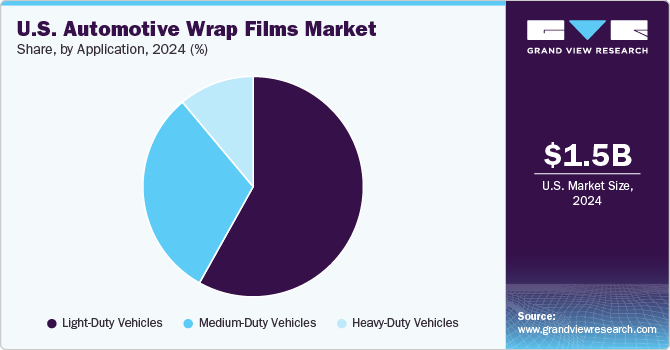
Amid the COVID-19 pandemic, these medium-duty vehicles are being widely used to distribute the essentials such as masks, food items, and others by non-government organizations and a wide range of companies as a part of their social responsibility. Medium-duty vehicles used for these purposes display the company or the organization name which largely contributes to the consumption of automotive wrap films.
Heavy-duty vehicles with graphics attract commuters’ interest and allow easy access to advertised information. Moreover, heavy-duty vehicles travel a long distance allowing access to millions of untapped people for the promotion of the company’s products and services. Different types of vinyl films are available for vehicle bodies and windows. For instance, in buses, the body is covered with opaque vinyl film while windows are covered with perforated and special quality films for maintaining visibility.
Key Companies & Market Share Insights
Companies operating in the U.S. market for automotive wrap films lay high emphasis on expanding their footprint in an attempt to drive their revenues and increase market shares. Companies are expanding their services in countries, such as Argentina, Colombia, Ecuador, Bolivia, French Guiana, El-Salvador, Brazil, and Chile, to cater to the rising demand for automotive wrap materials for commercial fleets in these economies.
Strategic partnerships, capacity expansions, and new product developments are the popular strategies adopted by a majority of players operating in the market. For instance, in June 2020, ORAFOL Europe GmbH introduced ORALITE VC 612 primarily used for fleet vehicles for marketing & advertising purpose and has a service life of 5 years. This product innovation will cater to fleet owners with high services of vehicle wraps.
Recent Developments
-
In May 2022, Avery Dennison invested 60 million euros in expanding its capacity and increasing its efficiency in manufacturing plants based in Europe. This includes a new automated warehouse and 5 new logistical buildings which are expected to open in 2024.
-
In June 2022, Hexis partnered with Bodyfence to launch 3 new adhesive films namely BFWIDE, DFENCEXTRM, and BODYFENCEXM.
-
In May 2021, Arlon Graphics, a pioneer in graphic film manufacturing globally, announced 3 virtual application demos. Installers of vehicle wraps are able to interact with technical experts easily and efficiently at these demo events and obtain hands-on experience with Arlon's FLITE Technology films.
Some of the prominent players operating in the U.S. automotive wrap films market are:
-
Avery Dennison Corporation
-
Arlon Graphics, LLC
-
3M
-
VViViD Vinyl
-
Hexis S.A.
U.S. Automotive Wrap Films Market Report Scope
Report Attribute
Details
Market size value in 2021
USD 1.29 billion
Revenue forecast in 2028
USD 4.32 billion
Growth rate
CAGR of 18.8% from 2021 to 2028
Base year for estimation
2020
Historical data
2017 - 2019
Forecast period
2021 - 2028
Quantitative units
Revenue in USD million & CAGR from 2021 to 2028
Report coverage
Volume forecast, revenue forecast, competitive landscape, growth factors and trends
Segments covered
Location, application
Country scope
U.S.
Key companies profiled
Avery Dennison Corporation; Arlon Graphics, LLC;3M;VViViD Vinyl; Hexis S.A.
Customization scope
Free report customization (equivalent up to 8 analysts working days) with purchase. Addition or alteration to country, regional & segment scope.
Pricing and purchase options
Avail customized purchase options to meet your exact research needs. Explore purchase options
U.S. Automotive Wrap Films Market SegmentationThis report forecasts revenue growth at the country level and provides an analysis of the latest industry trends in each of the sub-segments from 2017 to 2028. For this study, Grand View Research has segmented the U.S. automotive wrap films market report based on location and application:
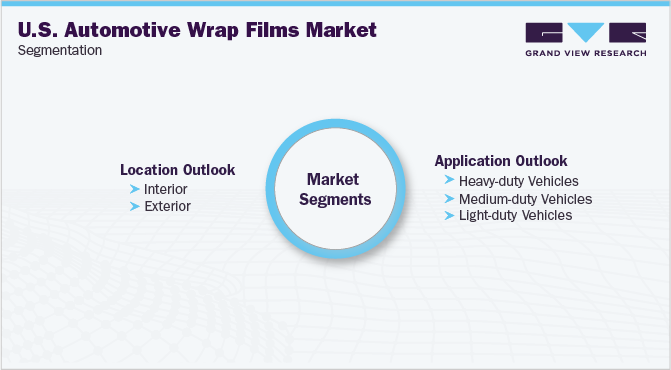
-
Location Outlook (Revenue, USD Million, 2017 - 2028)
-
Interior
-
Exterior
-
-
Application Outlook (Revenue, USD Million, 2017 - 2028)
-
Heavy-duty Vehicles
-
Medium-duty Vehicles
-
Light-duty Vehicles
-
Frequently Asked Questions About This Report
b. The U.S. automotive wrap films market size was estimated at USD 1.18 billion in 2020 and is expected to reach USD 1.29 billion in 2021.
b. The U.S. automotive wrap films market is expected to grow at a compound annual growth rate of 18.8% from 2021 to 2028 to reach USD 4.32 billion by 2028.
b. Light-duty vehicles dominated the U.S. automotive wrap films market with a share of 53.8% in 2020. This high share is attributable to the rising demand for wrap films as a cost-effective solution compared to vehicle paint, especially for high-end vehicles such as Audi, Mercedes, Porsche, Volkswagen, and BMW.
b. Some of the key players operating in the U.S. automotive wrap films market include Avery Dennison Corporation, Arlon Graphics, LLC, 3M, VViViD Vinyl, and Hexis S.A.
b. Key factors driving the U.S. automotive wrap films market growth include the rising trend of advertising on automobiles coupled with the growing popularity of automotive wrap films for vehicle customization.
Share this report with your colleague or friend.
![gvr icn]()
NEED A CUSTOM REPORT?
We can customize every report - free of charge - including purchasing stand-alone sections or country-level reports, as well as offer affordable discounts for start-ups & universities. Contact us now
![Certified Icon]()
We are GDPR and CCPA compliant! Your transaction & personal information is safe and secure. For more details, please read our privacy policy.
We are committed towards customer satisfaction, and quality service.
"The quality of research they have done for us has been excellent."
